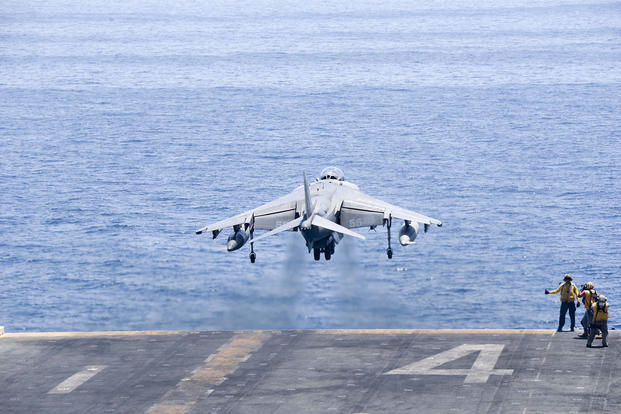Iraqi Security Forces this week began a long-awaited offensive on the town of Mosul in northern Iraq to flush Islamic State militants out of their last stronghold in the country.
But months before, aircraft from the 13th Marine Expeditionary Unit were already preparing for the assault by strategically eliminating weapons and fighters in the region.
AV-8B Harriers based aboard the USS Boxer conducted 45 combat sorties over Mosul and Al Asad, Iraq, eliminating 20 targets over the course of 27 days. Col. Anthony Henderson, commanding officer of the MEU, told reporters at the Pentagon on Thursday that targets ranged from machine gun bunkers and mortar positions to fighters who were maneuvering against Iraqi Security Forces.
"From the anecdotal feedback, it diminished not only ISIL's capacity for some of its strengths, which were the ability to shoot indirect fire, the ability to maneuver its fighters," Henderson said, using an acronym for the Islamic State. "I also think that it encouraged the Iraqi Security Forces that they still had a U.S. commitment to support them as they were attempting to battle ISIL."
The six Harriers aboard the Boxer would conduct three-aircraft missions, covering some 1,600 nautical miles to and from the ship's position in the Mediterranean, Henderson said.
The amphibious ready group carrying the 4,400 Marines and sailors also spent time in the Gulf of Aden, where they conducted maritime security operations in the Yemeni seaport of Al Mukalla, patrolling the waters in support of United Arab Emirates efforts to thwart efforts by Al-Qaida on the Arabian Peninsula [AQAP] to control the region.
Traveling in the small rigid-hulled inflatable boats commonly used by Naval Special Warfare operators, Marines and sailors spent more than 40 days patrolling the region, inspecting dhows, or sailboats, in the harbor for signs of illicit activity such as weapons smuggling or fighter movements.
Henderson said the troops completed their patrols without any major incidents. And while this month Navy ships in the Red Sea were targeted by missiles launched from the coast of Yemen, Henderson said there were no attacks of that nature.
"Pretty much, they knew we were out there, so they were less inclined to move across waterways to provide those types of supplies," he said. "And that was the effect we wanted with that."
The Marines and sailors did, however, come across several dhows carrying hundreds of refugees from nearby Somalia. Sometimes, he said, they'd have been drifting for days and the people on board would be dehydrated in the hot Middle Eastern sun. The troops determined the refugees did not require medical care, but offered them supplies and information.
"We helped them at sea," Henderson said. "We gave them water, food -- pointed them in the direction they were trying to go."
In total, the MEU was deployed for 213 days, returning home to California on Sept. 12 after participating in multiple high-profile training missions and operations.
"We trained very aggressively to the closest point of failure," Henderson said of how the MEU prepared for the deployment. "We assessed, we learned, and we trained again."
-- Hope Hodge Seck can be reached at hope.seck@military.com. Follow her on Twitter at@HopeSeck.






























